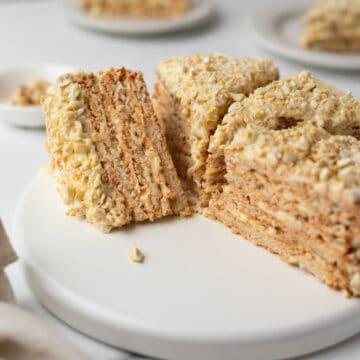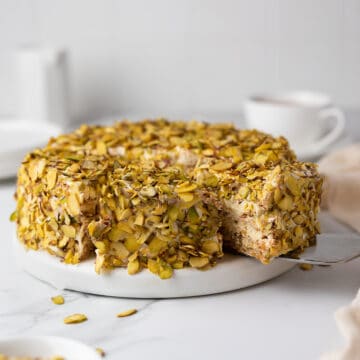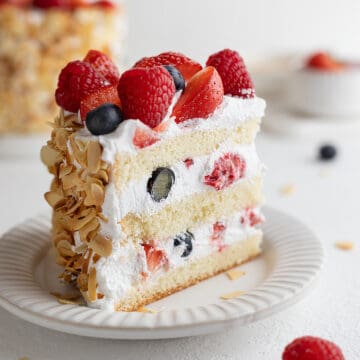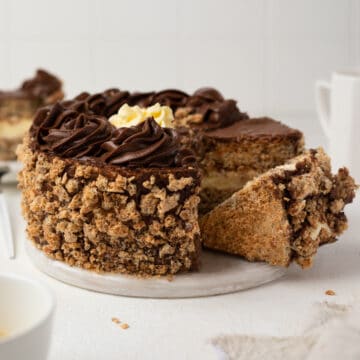San Sebastian cheesecake, also known as Burnt Basque cheesecake, is a showstopping dessert with its signature burnt top. The creaminess of the inside and caramelized crust make this modern Spanish dessert absolutely unique.

San Sebastian cheesecake
San Sebastian cheesecake, or Burnt Basque cheesecake, is a crustless cheesecake of Spanish origin with a creamy interior and a signature burnt top. It has other names, such as St. Sebastian cheesecake or Saint Sebastian cake.
Jump to:
This cheesecake has a signature burnt surface. Therefore, the name is burnt cheesecake or even burnt cheese (a short name).
Its truly distinctive and incomparable burnt flavor, resembling salted caramel or browned butter, is so intense that it must be tasted firsthand.
Its golden brown top and burnt appearance hide a soft and melting center. The texture of Basque cheesecake is creamy, light, and airy, less dense than regular cheesecake, and has its own unique flavor.
There is no need for a water bath required to make a classic New York style cheesecake. Instead, the Basque-style cheesecake is baked at high temperature without a water bath.
Let's say that I haven't met anyone who could resist a delicious slice of this cheesecake. Here is my foolproof recipe!

Ingredient list
For ingredients and detailed instructions, refer to the recipe card below.
The Basque burnt cheesecake recipe calls for a few simple ingredients. Use all the ingredients at room temperature. It prevents making a lumpy cheesecake batter that is prone to cracking.
- Cream cheese - full-fat cream cheese sold in the United States under the brand name Philadephia®. It must be at room temperature! Please don't confuse cream cheese with whipped cream cheese or reduced fat.
- Sugar - white sugar (granulated or caster sugar).
- Eggs - five large eggs at room temperature, but feel free to go for seven if desired.
- Heavy cream with 36-38% fat content. You can try using light whipping cream instead, but I haven't tried this recipe with whole milk or a non-dairy alternative, such as full-fat canned coconut milk.
- Flour - a little flour (all purpose or plain flour) is essential.
How to make San Sebastian cheesecake step-by-step
Step 1. Preheat the oven to 430°F (220°C) for at least 30 minutes; even better, longer!
Pro tip: A very hot oven with extended preheating guarantees the signature burnt look of cheesecake.
Step 2. Butter a 9-inch (23 cm) springform pan and line it with two sheets of parchment paper.
Pro tip: Try to overlap two sheets of parchment to match their center and press the paper at the bottom and against the edges to adhere to the pan.
Let the parchment stick up at least 2 inches (5 cm) above the sides of the pan; don't let it overhang down! If you fold down the parchment, some batter might overflow during baking.
Don't try to line the mold perfectly. Instead, the parchment has to be pleated and folded around the outer edges by design to bring the iconic look to Basque cheesecake.
Pro tip: If a spring form pan is unavailable, use a regular round pan with at least 3-inch (7.5 cm) tall sides. Make sure to line it with two sheets of parchment as recommended in the recipe.
If your cake pan is 2 inches (5 cm) deep, make sure two to three sheets of parchment paper go at least 4 inches (10 cm) above the pan's sides to support the batter.
Step 3. In the mixing bowl of a stand mixer fitted with the paddle attachment, beat Philadelphia cream cheese and sugar at medium-low speed for about 2-3 minutes until creamy (photo 1).
Pro tip: Scrape the sides of the bowl with a rubber spatula regularly while making the cheesecake batter.
Step 4. Add eggs, one at a time, mixing well between each. Then add heavy cream and mix at low for about 30 seconds. Finish with the sifted flour, mixing at a low speed until smooth (photo 2).
Pro tip: If you use a KitchenAid stand mixer, mix the cheesecake batter on speed "2" from the moment you add eggs.

PHOTO 1

PHOTO 2
Step 5. Pour the cream cheesecake mixture into the prepared pan, using the back of a spoon, and smooth the top (photo 3).
Step 6. Bake on the oven rack for 40 minutes, until it is nice dark brown on top (photo 4).

PHOTO 3

PHOTO 4
Pro tip: Bring the pan into the hot oven fast. Don't let the hot air escape!
Bake the cheesecake on the middle rack with a convection oven with a fan.
With a conventional oven (no fan), bake the cheesecake on a rack higher than the middle one. But make sure to have a space till the oven's ceiling: the paper shouldn't touch the heating element of the oven!
Watch the last 5-10 minutes carefully so that it doesn't burn beyond that. The center must be a little jiggly and shaky, like a flan.
If the cheesecake doesn't look "burnt" after the recommended bake time, turn it to broil/grill it for 1 to 2 minutes.
But be careful - don't overdo it! Pay close attention - broiling/grilling will darken the cheesecake very quickly!
Step 7. Take it out of the oven and let it cool to room temperature for at least 4 hours.
Leave the cheesecake with parchment paper until it is ready to be sliced and served; otherwise, it might start to lose its shape.
Serve it the same day or chill it in the fridge overnight. For serving, unmold the cheesecake, carefully peeling away the parchment from the sides of the cake.

Expert Tips
- Make sure all the cheesecake ingredients are at room temperature.
- Always use two sheets of parchment paper to line a springform pan, ensuring that it sticks up at least 2 inches (5 cm) to prevent the batter from overflowing while baking.
- Don't overmix the batter: add each ingredient and mix until just combined.
- Don't overbake your cheesecake by extending the baking time; even if the top doesn't brown after 40 minutes of baking, use broil or grill for 1-2 minutes. With overbaking, there is a risk of the filling being curdled: you won't be able to fix it!
- Remember that each oven is different, and you might need to adjust the baking time, but never open the oven door while baking.
- Dip the knife's blade in hot water to cut cheesecake and dry it with a kitchen towel between each cut. Then, with one quick motion, cut the slice for a clean cut.
- Make-ahead option: Cheesecake can be made one day ahead. Chill it in the refrigerator overnight. But make sure to let the cheesecake sit for at least 30 minutes at room temperature before serving.
Recipe variations
Texture: Depending on the cheesecake's doneness, you can get it creamy, creamy with the oozy raw-like center, or firm, resembling regular cheesecakes, each with its own perks.
- Bake the cheesecake as recommended and serve it at room temperature to get the creamy texture.
- Bake the dessert slightly less than advised and chill well before slicing for raw texture. Once chilled, bring it to the counter 30 minutes before serving.
- To get the firm-textured cheesecake, bake it as recommended and chill it for at least 12 hours. Then, slice it cold from the fridge.
Flavors: Don't limit yourself to one type of flavor.
- "If you want salt, add salt; if you want vanilla, add vanilla; some people add lemon zest, "says the inventor of burnt cheesecake, chef Santiago Rivera.
- Add a teaspoon of vanilla extract, lemon juice, dark rum, or whiskey.
- Add chocolate, matcha, or pistachio paste to make chocolate, matcha, or pistachio variations.
And if you ever want to make mini Basque cheesecake, there is a recipe on the blog.
How to serve it
Burnt Basque cheesecake tastes great the next day and even a few days after making it.
Serve it on a serving plate, keeping the browned baking paper: it brings a rustic look.
It is best served at room temperature with chocolate sauce, a glass of Pedro Ximenez sherry wine, or other nice dessert wine.
Storing and freezing
Store the cooled Basque cheesecake in an airtight container in the refrigerator for up to 3 days. Bring it to room temperature for at least 30 minutes, better longer, before serving.
To freeze the whole cheesecake, unmold it once cooled, remove the parchment paper, and let it freeze on a plate for at least 1-2 hours. Then, cover it with double plastic wrap and a layer of aluminum foil and freeze the dessert for up to 3 months.
To freeze cheesecake slices individually, wrap each in cling film and aluminum foil and freeze for up to 3 months.
To thaw, bring it to the fridge overnight. The best way to serve your cheesecake is by getting it out of the refrigerator at least 30 minutes before slicing.
Troubleshooting cheesecake
My cheesecake is runny
Reason: If your cheesecake is still runny after chilling for 12 hours, it is underbaked.
How to prevent it: Bake the cheesecake for a few more minutes next time.
My cheesecake is cracked on top
Reasons: The top of the cheesecake can crack due to
- Overmixing the batter
- Excess of air bubbles with whisking
- Opening the oven door while baking
How to prevent it:
- Don't overmix the batter (otherwise, it traps air bubbles)
- Tap the cake pan slightly to remove excess air bubbles.
- Never open the oven door within the first 30-40 minutes of baking.
Rarely broiling/grilling can make the cheesecake crack. In the end, the cracks would close once the cheesecake fell as it cooled.
Recipe FAQ
The cheesecake is named after the town of San Sebastian in the Basque region of Northern Spain, where it was first created.
Basque cheesecake doesn't have a base or some cookie crust typical for traditional cheesecake.
The main difference is that the Basque cheesecake is a crustless, light, and airy treat that is typically unflavored and baked until burnt at high oven temperature without a water bath.
This cheesecake is not gluten-free since it contains a bit of flour. To make gluten-free burnt Basque cheesecake, replace regular flour with rice flour or cornstarch.
Love easy cakes? Try these next!
HUNGRY FOR MORE? Subscribe to my newsletter and follow me on Facebook, Pinterest, and Instagram for my latest updates.
PrintSan Sebastian Cheesecake (Burnt Basque Cheesecake)
San Sebastian cheesecake, also known as Burnt Basque cheesecake, is a crustless cheesecake with creaminess inside and a signature burnt top.
- Total Time: 55 minutes
- Yield: 12 slices 1x
- Category: Cakes
- Method: Baking
- Cuisine: Spanish
Ingredients
- 4 ½ blocks (1 kg) of full-fat cream cheese (Philadelphia), room temperature
- 1 ¼ cup (250 g) granulated sugar
- 5 large eggs, room temperature
- 2 cups + 2 teaspoons (480 ml) heavy cream, room temperature
- 4 tablespoons (30 g) all-purpose flour
*Don't you have the correct baking pan on hand right now? Try this simple Cake Pan Converter!
** If needed, please refer to Baking Conversion Charts.
Instructions
-
Preheat the oven to 430°F (220°C) for at least 30 minutes; even better, longer! The very hot oven with extended preheating guarantees the signature burnt look of cheesecake.
-
Butter a 9-inch (23 cm) springform pan and line it with two sheets of parchment paper. Try to overlap two sheets of parchment to match their center, and press the paper at the bottom and against the edges to adhere to the pan. Let the parchment stick up at least 2 inches (5 cm) above the sides of the pan; don't let it overhang down! If you fold down the parchment, some batter might overflow during baking. Also, don't try to line the mold perfectly. Instead, the parchment has to be pleated and folded around the outer edges by design to bring the iconic look to Basque cheesecake.
-
In the mixing bowl of a stand mixer fitted with the paddle attachment, beat Philadelphia cream cheese and sugar at medium-low speed for about 2-3 minutes until creamy. Scrape the sides of the bowl with a rubber spatula regularly while making the cheesecake batter.
-
Add eggs, one at a time, mixing well between each. Then add heavy cream and mix at low for about 30 seconds. Finish with the sifted flour, mixing at a low speed until smooth. If you use a KitchenAid stand mixer, mix the cheesecake batter on speed "2" from the moment you add eggs.
-
Pour the cheesecake mixture into the prepared pan, using the back of a spoon, and smooth the top. Bake on the oven rack for 40 minutes, until it is nice dark brown on top. Bring the pan into the hot oven fast. Don't let the hot air escape!
-
With a convection oven with a fan, bake the cheesecake on the middle rack. With a conventional oven (no fan), bake the cheesecake on a rack higher than the middle one. But make sure to have a space till the oven's ceiling: the paper shouldn't touch the heating element of the oven!
-
Watch the last 5-10 minutes carefully so that it doesn't burn beyond that. The center must be a little jiggly and shaky, like a flan. If the cheesecake doesn't look "burnt" after the recommended bake time, turn to broil/grill it for 1 to 2 minutes. But be careful - don't overdo it! Pay close attention - broiling/grilling will darken the cheesecake very quickly!
-
Take it out of the oven and let it cool to room temperature for at least 4 hours. Leave the cheesecake with parchment paper until it is ready to be sliced and served; otherwise, it might start to lose its shape. Serve it the same day or chill in the fridge overnight. For serving, unmold the cheesecake, carefully peeling away the parchment from the sides of the cake.
Notes
- Make sure all the cheesecake ingredients are at room temperature.
- Always use two sheets of parchment paper to line a springform pan, ensuring that it sticks up at least 2 inches (5 cm) to prevent the batter from overflowing while baking.
- Don’t overmix the batter: adding each ingredient, mix until just combined.
- Don't overbake the cheesecake by extending the baking time; even if the top doesn't brown after 40 minutes of baking, use broil or grill for 1-2 minutes. With overbaking, there is a risk of the filling being curdled: you won't be able to fix it!
- Remember that each oven is different, and you might need to adjust the baking time, but never open the oven door while baking.
- Serve your cheesecake on a serving plate, keeping the browned baking paper: it brings a rustic look.
- To cut cheesecake, dip the knife's blade in hot water and dry it with a kitchen towel between each cut. Then, with one quick motion, cut the slice to have a clean cut.
Nutrition
- Serving Size: 1 slice
- Calories: 548
- Sugar: 21.2 g
- Sodium: 291 mg
- Fat: 46.2 g
- Saturated Fat: 28.3 g
- Carbohydrates: 26.3 g
- Fiber: 0.1 g
- Protein: 10 g
- Cholesterol: 225 mg
The nutritional information has been calculated using an online recipe nutrition calculator such as Verywellfit.com and is intended for informational purposes only. These figures should be used as a general guideline and not be construed as a guarantee.













Keely says
Made the cheesecake. No questions; it's easy and delicious. Next time I'd like to make a pistachio version. Do you plan to post such a recipe?
Irina says
Hi Kelly, thank you for making the recipe and the idea for pistachio San Sebastian! 🙂
Naaz Parveen says
Love love love this recipe. Had tried San Sebastian Cheesecake at some cafes and just loved them. The slices would always be so expensive, so I decided to look up a recipe online, and I am so glad I came across this one. This cheesecake tastes even better than the ones I had out at cafes. Thanks so much for sharing this wonderful recipe with us!
Barbara says
I'd recommend real and true cream cheese and not Philadelphia as it is not actual cream cheese (lost the right to call itself that in Europe). Opt for a more natural version without the additives. It allows the other ingredients to react as intended.